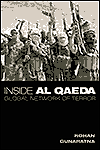|
| Home | About Kashmir Herald | |
Volume 3, No. 4 - September 2003 |
|
| Featured Article |
|
|
|
Learning from History The massacre of six million Jews by Hitler and the persecution they suffered all over the world in the last 15 centuries has been meticulously recorded after 1945 and has been enshrined not only in history books, but also in Holocaust museums, the most famous of these being the one in Washington DC. It has not been done with a spirit of vengeance: Look at Israel and Germany today, they are in the best of terms; yet, facts are facts and contemporary Germany has come to terms with its terrible actions during Second World War. Hindus too have suffered a terrible Holocaust, probably without parallel in human history. Take the Hindu Kush, for instance; probably, one of the biggest genocides in the history of Hindus. There has practically been no serious research on the subject or mention in history books. The Hindu Kush is a mountain system nearly 1,000 miles long and 200 miles wide, running north-east to south-west and dividing the Amu Darya valley and the Indus valley. The Hindu Kush has over two dozen summits of more than 23,000 feet and historically its passes, particularly the Khyber, have been of great military significance, for they provide access to the northern plains of India. Most foreign invaders have used the Khyber Pass: Alexander the Great in 327 BC, Mahmud of Ghazni, in 1001 AD; Timur Lane in 1398 AD; and, Nadir Shah in 1739 AD. Yet, in the first millennium before Christ, two major Hindu kingdoms, those of Gandhaar (Kandahar) and Vaahic Pradesh (Balkh of Bactria) had their borders extending far beyond the Hindu Kush. The kingdom of Gandhaar, for instance, was established by Taksha, the grandson of Bharat of Ayodhya, and its borders went from Takshashila (Taxila) to Tashkent (corruption of Taksha Khand) in present day Uzbekistan. In the later period, the Mahabharat speaks of Gandhaari as a princess of Gandhaar and her brother, Shakuni, as a prince and later as Gandhaar's ruler (the last Hindu Shahiya king of Kabul, Bhimapal, was killed in 1026 AD). Then came, in 3rd century BC, Buddhist emperor Kanishka, whose empire stretched from Mathura to the Aral Sea (beyond the present day Uzbekistan, Tajikistan, and Krygzystan) and under his influence Buddhism flourished in Gandhaar. The two giant Buddha sandstones carved into the cliffs of Bamian, which were destroyed by the Taliban, date from the Kanishka period. In Persian, the word 'Kush' is derived from the verb 'Kushtar' - to slaughter or carnage. Encyclopaedia Americana says of Hindu Kush: "The name means literally 'Kills the Hindu', a reminder of the days when Hindu slaves from Indian subcontinent died in harsh Afghan mountains while being transported to Moslem courts of Central Asia." Encyclopaedia Britannica on its part mentions "that the name Hindu Kush first appears in 1333 AD in the writings of Ibn Battutah, the medieval Berber traveller, who said the name meant 'Hindu Killer', a meaning still given by Afghan mountain dwellers". Unlike the Jewish holocaust, the exact toll of the Hindu genocide suggested by the name Hindu Kush is not available. "However," writes Hindu Kush specialist Srinandan Vyas, "the number is easily likely to be in millions." A few known historical figures can be used to justify this estimate. Encyclopaedia Britannica recalls that in December 1398 AD, Timur Lane ordered the execution of at least 50,000 captives before the battle for Delhi; likewise, the number of captives butchered by Timur Lane's army was about 100,000. Encyclopae-dia Britannica again mentions that Mughal emperor Akbar ordered the massacre of about 30,000 captured Rajput Hindus on February 24, 1568 AD, after the battle for Chitod, a number confirmed by Abul Fazl, Akbar's court historian. Afghan historian Khondamir notes that during one of the many repeated invasions on the city of Herat in western Afghanistan, which used to be part of the Hindu Shahiya kingdoms, "1,500,000 residents perished". "Thus," writes Vyas, "it is evident that the mountain range was named as Hindu Kush as a reminder to the future Hindu generations of the slaughter and slavery of Hindus during the Muslim conquests." Since some of the Muslim conquerors took Indian plainsmen as slaves, a question arises: Whatever happened to this slave population? The startling answer comes from The New York Times (May-June 1993). The Gypsies, who used to be wandering people in Central Asia and Europe since around the 12th century, have been persecuted in almost every country (the Nazis killed 300,000 gypsies in gas chambers). Until now their country of origin could not be identified, as their language has very little in common with the other European languages. Recent studies, however, show that their language is similar to Punjabi and to a lesser degree, Sanskrit. Thus the Gypsies probably originated from the greater Punjab. The time-frame of Gypsy wanderings also coincides with early Islamic conquests; hence, it is most likely their ancestors were driven out of their homes in Punjab and taken as slaves over the Hindu Kush. Why does not the Government of India tell Indian children about the Hindu Kush genocide? The horrors of the Jewish holocaust are taught not only in schools in Israel and the US, but also in Germany, because both Germany and Israel consider the Jewish holocaust a "dark chapter" in the history. Yet, in 1982, the National Council of Educational Research and Training (NCERT) issued a directive for the rewriting of school texts. Among other things, it stipulated: "Characterisation of the medieval period as a time of conflict between Hindus and Muslims is forbidden." Thus, denial of history, or negationism, has become India's official "educational" policy. Fortunately, the present Government of India has initiated a rewriting of History school books, although this policy has come under attack as "a dangerous saffronisation" of history. This is why the Forum Against Continuing Terrorism (FACT), which sponsored the recent exhibition in Delhi on the plight of the Kashmiri Pandits - an exhibition which opened also in Bangalore on September 1, and will be in Poland on September 10, and then in Berlin on the 15th - would like to start a project aiming at having a Holocaust Museum in New Delhi. It will record not only the genocide of Hindus at the hands of Muslim invaders, but also the terrible persecution by the Portugese (hardly mentioned, too, in Indian History books), or of the British (nobody knows that 25 millions Indians died in famine between 1815 and 1920, a genocide in the true sense of the term, as the Britsih broke the agricultural backbone of India for raw materials like Cotton, jute, etc. FACT needs the support of all Indians for this museum to come into existence, so that every Indian child knows his/her history and what his/her forefathers had to endure. [FACT, which stands for Forum Against Continuing Terrorism has three trustees: Francois Gautier, KG Suresh of PTI and another journalist, Deepak Bajaj. Its registered office is at 41 Jorbagh, New Delhi 110003 and this is where the cheques in the name of FACT can be sent, or else they can be directly credited to the FACT account: ICICI Bank Limited, New Delhi, Karol Bagh Branch, 2877, First Floor, Hardhyan Singh Road, Karolbagh, New Delhi 110 005, A/C No: 629105037071. For those donating abroad, they can also be donated via an organization which has a charity tax exemption (ours will take some time to be obtained), such as IDRF USA, or Kashmiri Overseas Association. FACT is in the process of obtaining tax exemption.] François
Gautier |
 |
 |
 |
|
|
Archives
| Privacy Policy |
Copyrights
|
Contact
Us | |
||